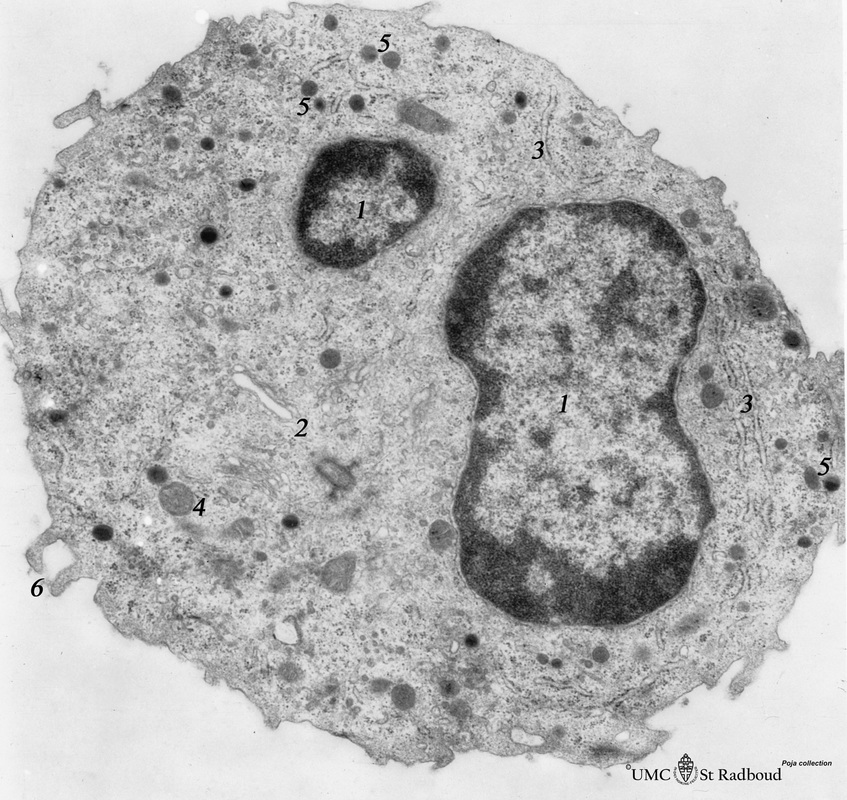1.1 POJA-L758
Title: Monocyte (peripheral blood, human)
Description: Electron microscopy.
In this picture the large nucleus (1) of this cell (diameter of 12-20 mm) is twice sectioned.
Golgi areas (2) and centriole, profiles of rough endoplasmic reticulum (3) and many free ribosomes are present.
There are many mitochondria (4) as well as scattered homogeneous electron-dense/-grey lysosomal granules (5) (primary or azurophilic granules with acid phosphatase, arylsulfatase) in variable amounts and sizes.
Thin filopodia (6) reflect the ameboid movement and phagocytic ability.
Background: The monocytes are the largest leukocytes and comprise 2-8% of the leukocyte population. They circulate in the bloodstream for about 8-20 hours, enter thereafter in the peripheral tissues as macrophages. But they may transform as well into antigen-presenting cells (APC’s). The cells possess receptors for Ig and complement and can participate in ADCC reaction (antibody-dependent cell-mediated cytotoxicity), can ingest and destroy microbes by means of oxygen intermediates, nitric oxide and lysosomal enzymes. The CD14 receptor on monocytes is important for the activation of the cell by endotoxins of Gram-negative bacteria. Monocytes also produce interleukins such as IL-10 and tumor necrosis factor.
Keywords/Mesh: blood, bone marrow, monocyte, lysosome, phagocytosis, histology, electron microscopy, POJA collection
Title: Monocyte (peripheral blood, human)
Description: Electron microscopy.
In this picture the large nucleus (1) of this cell (diameter of 12-20 mm) is twice sectioned.
Golgi areas (2) and centriole, profiles of rough endoplasmic reticulum (3) and many free ribosomes are present.
There are many mitochondria (4) as well as scattered homogeneous electron-dense/-grey lysosomal granules (5) (primary or azurophilic granules with acid phosphatase, arylsulfatase) in variable amounts and sizes.
Thin filopodia (6) reflect the ameboid movement and phagocytic ability.
Background: The monocytes are the largest leukocytes and comprise 2-8% of the leukocyte population. They circulate in the bloodstream for about 8-20 hours, enter thereafter in the peripheral tissues as macrophages. But they may transform as well into antigen-presenting cells (APC’s). The cells possess receptors for Ig and complement and can participate in ADCC reaction (antibody-dependent cell-mediated cytotoxicity), can ingest and destroy microbes by means of oxygen intermediates, nitric oxide and lysosomal enzymes. The CD14 receptor on monocytes is important for the activation of the cell by endotoxins of Gram-negative bacteria. Monocytes also produce interleukins such as IL-10 and tumor necrosis factor.
Keywords/Mesh: blood, bone marrow, monocyte, lysosome, phagocytosis, histology, electron microscopy, POJA collection

